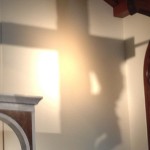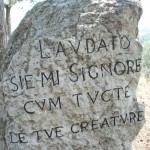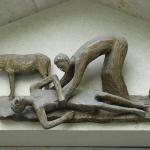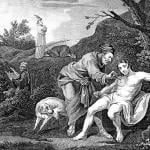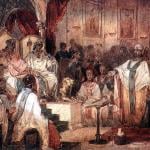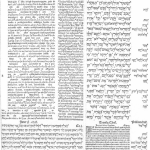I got my wish. Last week, the conclave elected as a successor to St Peter and to the retired Pope Benedict XVI a man who seems to embody the best of my two favorite popes (John XXIII and Benedict)—doctrinal faithfulness and pastoral joy. I even called St Joseph’s Day as the perfect date for the inaugural Mass. What I couldn’t predict is that the erstwhile Cardinal Bergoglio, with whose name I wasn’t even familiar when it was announced, would take the papal name and embody the best of my favorite saint, too.
I know, I know. This is not about me. But I wanted to note that one of the reasons I hadn’t yet posted my reaction to Pope Francis is that I’ve basically spent a week glued to the coverage, going SQUEEEEEEEE!
Another reason for the delay is what Max Lindenman basically referred to as blog irregularity, caused by the glut of rich and varied posts already out there. What could there possibly be to say, that hadn’t already been said and said beautifully by our Patheos Catholic Channel peeps and the rest of the Catholic media world? (Check out the Patheosi here. Special props to our own editor, The Anchoress Elizabeth Scalia, for reporting from Rome even while sidelined by illness.) Max unblocked himself with a terrific post, but it’s taken me longer . . . and the length of this post reflects it.
What finally got me thinking and blogging was not the usual fisking of MSM silliness (of which there is plenty) or the early signs that not everybody is SQUEEing as much as I am. (Very thoughtful posts on that from The Crescat and Andrew Haines [H/T Deacon Greg Kandra]; I recommend them to your attention.) No, what struck me about Pope Francis is that he just may be a pope for our hoarding times.
When I wasn’t watching papal coverage last week, I indulged in my usual Friday-night marathon of Hoarders, the A&E reality series about people with hoarding disorder. (I watch it as compulsively as my mother read the obituaries in the two months between her inoperable lung cancer diagnosis and her death, and for pretty much the same reason: to gauge the level of my disorder. “Hah! Beat that one!” Mom would crow at the death notice of someone younger than she, or she’d simply sigh at the knowledge that anybody over 65 had enjoyed more time than she would.) Watching, I started thinking about the parallels between hoarders and the Church.
Wait! By the Church I don’t mean the eternal, unspotted, infallible Bride of Christ, but the earthen vessel we are in the world. And I don’t mean the Church-THEM—the Vatican, the Curia, the old men in the pointy hats—but the Church-US. That includes the Vatican, the Curia, the old men in the pointy hats, the magisterium of bus-rising nuns, the ordained, the laity, the left, the right, the confused, the suburbanites in Beavercreek, Ohio, and the thousands who walk barefoot for miles to gather for my Ugandan friend Fr Simon’s pre-Christmas retreat, the people at Adoration right now and the people who haven’t darkened a pew since Confirmation, the sinners, the saints, the whole “All Are Welcome” passel of us.
From my own experience and the research on hoarding disorder, hoarders share certain characteristics. And I humbly submit that the Church does, too, to some degree and in some measure. And I think Pope Francis might just be the intervention we need. Here’s why:
Hoarders have difficulty prioritizing. We’re missing—by nature or nurture or both—some key organizational neurons. To us, everything is important, everything has profound meaning, everything is unique. When asked to sort a pile of 16 objects into categories, healthy people can usually find a way to group them into 3 or 4 piles; hoarders inevitably come up with 16 separate categories, each containing one object. (This is one reason we don’t make good file clerks.) We don’t know where to start when asked to clean up. On Hoarders, participants are asked to sort their hoarded possessions into three categories: Keep, Donate, Throw Away. Most spend the entire first day of a 2-day intervention frozen, staring into one small box full of unrelated objects, unable to make a move or a choice. And of those that place things in the Donate or Trash pile, most go back at the end of the day and retrieve everything from the Goodwill bin or the 1-800-Got-Junk Dumpster.
A hoarder Church sometimes forgets what to keep and what to trash, which hills are worth dying on. We want to throw the baby out with the baptismal water, or keep all the baptismal water along with the babies. We forget that here is—and this is dogma—a hierarchy of dogma. Some things we aren’t going to, and shouldn’t, throw away. Some things are disciplines, not doctrines, and subject to review. Right now, we have to trust that Pope Francis is guided by the Holy Spirit to help us make those hard choices as a Church. Lots of us are scared he’ll put the wrong things on the Throw Away pile, or worried he’ll want us to Keep too much. I think we need to pay attention to that Donate pile, which often goes ignored: this pope is all about reducing, reusing, and recycling, which in evangelical terms is about preserving what is good and beautiful and true, passing it along to those who are in need of what we have to share, and letting the rest go.
. . . . .
Hoarders form attachments to things, not people. All the emotional intensity that healthy people put into relationships, we hoarders lavish on stuff. Sometimes it’s because the stuff reminds us of people we used to have relationships with, or fills up the emptiness left by people who are gone; sometimes it’s just that things are so much less complicated, so much more immediately gratifying, than people. It can start with good stuff: family memorabilia, books, art, antiques, the dreaded “collectibles,” craft and hobby supplies. But then it escalates, without intervention, to the unnecessary (home shopping channel binges, thousands of pairs of shoes), the inexplicable (empty boxes, packaging, newspapers and junk mail older than our children), and the toxic (garbage, trash, the waste of pets and pests). Even when we know better, we can’t let go without help. “I miss my stuff,” I confessed to my son just a week ago. “Your stuff,” he replied firmly, “does not miss you.” He helped me see that I thought I was craving objects because the flu going around had canceled our nightly family dinners for a stretch; it was family, not stuff, I craved.
A hoarder Church clings to red shoes and gold lace or tambourines and liturgical dancewear. It invests its love in marble and paintings and manuscripts—all of which are good and beautiful and worth saving—and turns away from people, who can be bad and are often ugly but are even more worth saving. A hoarder Church identifies itself, trad or prog, by its stuff. It is just as wrong to crow over the simplicity of Pope Francis’ vestments and worn black lace-ups as it is to mourn the absence of finery. “Your stuff does not miss you,” the pope said to the cardinals and all of us in his first post-conclave homily, when he made very clear the difference between objects and people: “To build the Church. There is talk of stones: stones have consistency, but [the stones spoken of are] living stones, stones anointed by the Holy Spirit. Build up the Church, the Bride of Christ, the cornerstone of which is the same Lord. With [every] movement in our lives, let us build!”
. . . . .
Hoarders are often highly intelligent, but lack practical skills. We think, we don’t do. We live in our heads. It’s often true that no one modeled for us the simplest steps for keeping a house clean or a checkbook balanced, and we came to believe those things weren’t important in comparison to our inner lives, our theorizing and debating and squirreling of data. Even if we wanted to roll up our sleeves and get our hands dirty, we haven’t got the faintest notion how to go about it, and we’re too proud to ask.
In a hoarder Church, the result is widening division between those who teach and preach about practical Gospel living, and those who do it. It’s no coincidence that Papa Francesco, whose actions speak louder than his words about the inseparable relationship between doctrinal faithfulness and social justice, is a man who knows how to cook his own meals and make his own bed and pay his own bills. And seems happy to teach, not mock, anyone who doesn’t.
. . . . .
Hoarders are secretive. We burrow. We lock ourselves into a lifelong conclave. At first the secrecy has a kind of twisted protective function: “Don’t tell what a mess my house is. What a mess I am.” If we’re in deep enough (and I was, and am), the secrecy gets to be a game, a challenge, an addiction. I know something you don’t know.
A hoarder Church has forgotten the difference between necessary confidentiality and secrecy for secrecy’s sake. When knowledge becomes power and power is restricted to an elite, there will be both treacherous leaks and calumnious rumors. As is true with alcoholism (a comorbidity of many hoarders like me), a hoarder Church is only as sick as our secrets. Sunlight is the best disinfectant, and transparency is nothing to fear for the followers of Christ, who instructed us to shout what we know from the rooftops. We don’t have specifics on this from Papa Francesco yet, but I suspect he’s not going to be one for hiding the light of truth and the workings of the Church under a curial bushel basket. Nor is he a blabber; he appears to know what things to treasure, like Mary, in the silence of his corazón.
. . . . .
Hoarders construct elaborate rituals of avoidance. We use rules and routines to keep the chaos of our lives at bay—even when those rules and routines are illogical, crazy, and end up contributing to the chaos. If I pile the trash bags neatly, they will no longer be full of rotting food. If I carefully, at the same time every day, clear the 3-foot-square area around the couch where I live, work, eat, and sleep, I am organized.
For a hoarder Church, elaborate liturgies and imperial ceremonies can be rituals of avoidance. So can demonstrations against celibacy and calls for gay marriage and the ordination of women. Pope Francis seems intent on interrogating rituals of all kinds, which cannot but cause us to look at what we may be using them to avoid.
. . . . .
Hoarders deny and defend. We get to be pretty good actors, putting up a front. We lie—habitually, and with proficiency, even when it serves no particular purpose. Most of all, we lie to ourselves, and come to believe the lies. I’m fine. I’ve got it under control. I’ll take care of this tomorrow. The check is in the mail. It’s not my fault. I’m trying. I did my best. And when those who care for us or care for the truth call us to accountability, we turn on them viciously. The mask comes off, and the monster takes possession. I use that word deliberately. My spiritual director in Dayton helped me see clearly that living with hoarding disorder is daily spiritual warfare. We are particularly vulnerable to the Father of Lies, since our whole persona is built on untruth.
A hoarder Church fears candor and truth. The Church as the spotless Bride of Christ cannot lie, but we who are the Church can, and do, often unconsciously, often with what we believe to be good motives. But as we see again and again, denial and defense don’t set us free: only the Truth can do that. Denying and defending those who abuse only redoubles the abuse, making room for the seven demons swept out the door to come back in with reinforcements. Pope Francis knows and speaks frankly about telling the truth and shaming the devil. He’s already called out the Father of Lies by name several times since being elected. And he has no use for masks. “Is it worthwhile to try if the world continues its carnival dance disguising everything for a while?” he asked, in his Lenten message to the Archdiocese of Buenos Aires. “However, when the mask falls, the truth appears. . . Today we are again invited to undertake a paschal journey to Truth, a journey that includes the cross and renunciation, which will be uncomfortable but not sterile. We are invited to admit that something is not right in ourselves, in society and in the Church, to change, to turn around, to be converted.”
. . . . .
Hoarders carry unspoken burdens of brokenness and shame. Well, really, in a world marred by sin, who doesn’t? But we hoarders have a unique need to cling to our woundedness at the very same time we struggle to keep it hidden. Nobody knows the trouble we’ve seen . . . because we won’t acknowledge it. We don’t need your stinkin’ pity, because we’re so good at pitying ourselves.
A hoarder Church is both abuser and abused, broken and ashamed and reluctant to talk about it. Conversion is a constant and ongoing necessity, even—especially—for the Bride of Christ. But what we are called to seek and to offer, over and over without ceasing, is not pity but merciful forgiveness, which is another name for the joy that heals. Preaching at the Vatican parish of Sant’Anna last Sunday morning, Pope Francis sounded the note that has been his theme throughout his ministry: “Mercy is the Lord’s most powerful message. It is not easy trust oneself to the mercy of God, because [His mercy] is an unfathomable abyss—but we must do it! . . . We ask for the grace of never tiring of asking pardon, for He never tires of pardoning.”
. . . . .
Hoarders are deathly afraid of human intimacy. We may go through the motions, but when it comes to real closeness we hoarders go all Smeagol-y: “It burnssss, it burnssss!” We shut people out, literally and metaphorically. Married couples in which one or both partners have hoarding disorder almost never share physical intimacy, for example, let alone the simple gestures of affection and human contact that most people take for granted. The fear is paralyzing, and brings about self-fulfilling prophecies of isolation and abandonment.
A hoarder Church has a conflicted relationship with human touch, relationship, intimacy, the flesh. We veer from gnostic distaste that verges on existential horror to the overblown holy eroticism of some Theology of the Body proponents, from huggy exchanges of the peace and handholding during the Lord’s Prayer to ascetic withdrawal. A hoarder Church forgets that we are the Church of Jesus, who was unafraid of the most intimate and scary contact with humanity—touching and being touched by, embracing, washing the road-filthy feet of sinners and children and the diseased and women and the ritually unclean and the dead, who was equally happy (and irresistibly welcome) inviting himself into the well-defended homes of the tax collector Zacchaeus and the Pharisee Simon. The divine human touch of Jesus is neither casually touchy-feely nor prudishly pro forma: it sees, stops, looks into and is looked into by the eyes of the soul, makes and accepts contact to shatter the walls and heal the wounds. The pope who named himself for the saint who kissed a leper on the mouth can show us how to touch and be touched as Jesus did. He already has. Look here.
. . . . .
Hoarders have a hard time believing that they—we, I—are loved and can change. And it’s true that without loving intervention and a commitment to ongoing therapy, the recidivism rate for serious hoarders is 100%. We can’t be “cured.” But we can be saved, and healed, and learn to accept and return the love that is there. And we can work like hell, every day, to hold onto the heaven that we get a glimpse of in a friend’s support, a grandson’s grin, a bed with clean sheets, an expanse of bare floor, a kitchen where meals can be prepared and shared, running water, an open door.
There is hope, always, for a hoarder Church, too. God has sent us an intervention to keep us from despair, that terrible sin against the Holy Spirit. God has sent us a professional organizer to help us prioritize, the cool sweet running water of a sense of humor, a friend who won’t enable us or put up with our caca, the reminder of the ongoing therapy that is ours in the Sacraments. “Rend your hearts to be able to love with the love with which we are loved, to console with the consolation that consoles us and to share what we have received,” Pope Francis encourages us.
Jesus, in his Vicar Francis, is knocking at the door. With God’s grace, we will let him in.


